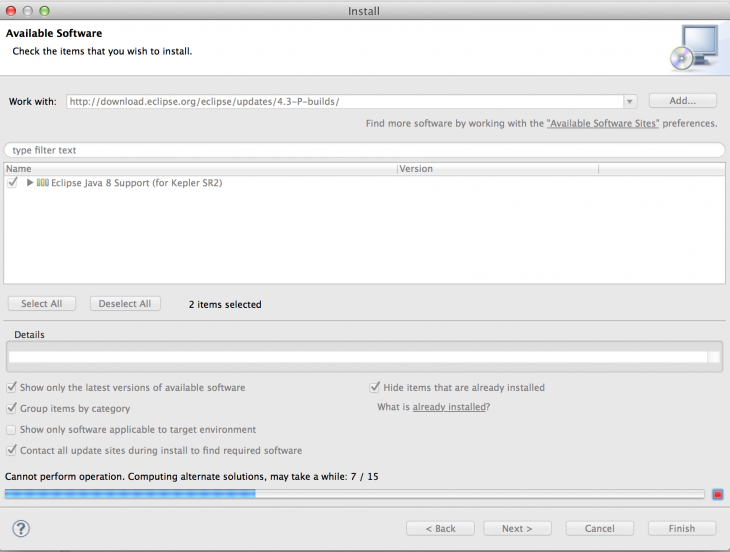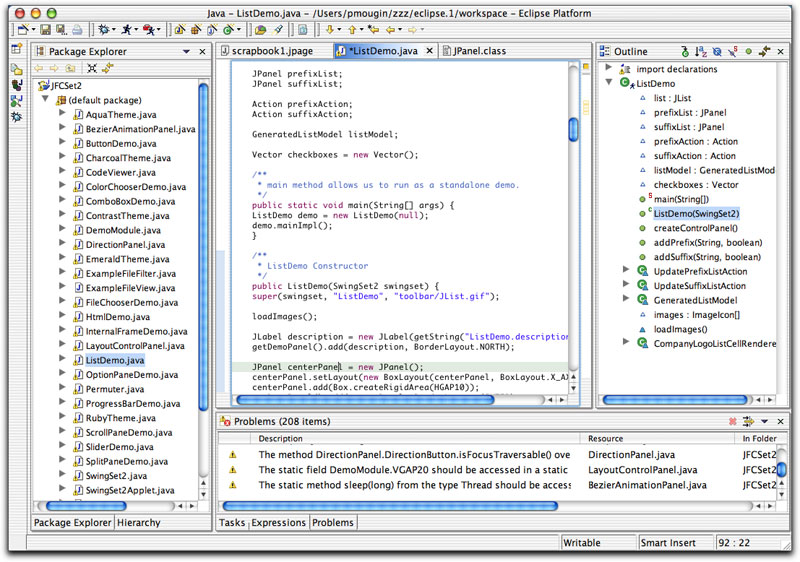Eclipse For Mac Java
- Eclipse Mac Java 11
- Eclipse Mac Javahl
- Eclipse For Mac Javafx
- Eclipse For Mac Java 8
- Eclipse Java_home Mac
Mac OS X; Unzip into eclipse installation directory; There should be new files in ECLIPSEROOT/plugins and ECLIPSEROOT/features; Run Eclipse; Hello World Creating JavaFX Project and configuring JavaFX SDK. Start eclipse. You will see the basic layout of workbench. In Package Explorer view click right mouse and select New Java Project.
- Write C/C on Mac with Eclipse, no Xcode. She taught him how to use Eclipse on a Mac, even though he resisted at first. You’ll need to download the Java runtime before the Eclipse app.
- Best JAVA IDE for beginners and advanced users Eclipse. Eclipse is the world’s most popular open source IDE for developing Java applications. The IDE is powered by the Java programming language. 1000s of small and large IT firms are using Eclipse since 2011. Eclipse runs on Linux, Mac, and Windows operating systems.
- I am Java developer who is using Eclipse on a X86 computer to code. I am considering to buy for other reasons an Desktop Mac computer and I would like to use this computer to do my coding work.
Some times if you are a new macOS user or even pro, it takes some time to find out which Java version I’m running with? What if you want to use Java 1.7 with Eclipse IDE?
While running Eclipse with new Macbook, you may see an error about installing Java SE 6. Follow steps mentioned in that tutorial to fix it. But after finish installation, you may need to switch between JRE’s like 1.6, 1.7 or 8 (latest Java). Well if you have any of below questions then you are at correct location.
- Where is Java installed on my Mac OS X system?
- How can I setup latest JDK 1.7.X to default workspace in Eclipse in Mac?
- JRE 7 Installation for Mac OS X
- Important Java Directories on Mac OS X
- Where is Java 7 Installed on Mac OS X?
- How to switch JDK version on Mac OS X
- Mac OS X Platform Install FAQ
There are two ways you could install Java on macOS:
Option-1) Command line:
Downloading Java JDK on Linux via wget is shown oracle.com license page instead.
Download JDK 12.0
macOS:
wget--no-check-certificate-c--header'Cookie: oraclelicense=accept-securebackup-cookie'https://download.oracle.com/otn-pub/java/jdk/12+33/312335d836a34c7c8bba9d963e26dc23/jdk-12_osx-x64_bin.tar.gz |
Linux:
wget--no-check-certificate-c--header'Cookie: oraclelicense=accept-securebackup-cookie'https://download.oracle.com/otn-pub/java/jdk/12+33/312335d836a34c7c8bba9d963e26dc23/jdk-12_linux-x64_bin.rpm |
Windows:

wget--no-check-certificate-c--header'Cookie: oraclelicense=accept-securebackup-cookie'https://download.oracle.com/otn-pub/java/jdk/12+33/312335d836a34c7c8bba9d963e26dc23/jdk-12_windows-x64_bin.exe |
Download JDK 11.0.2
macOS:

wget--no-check-certificate-c--header'Cookie: oraclelicense=accept-securebackup-cookie'http://download.oracle.com/otn-pub/java/jdk/11.0.2+9/f51449fcd52f4d52b93a989c5c56ed3c/jdk-11.0.2_osx-x64_bin.tar.gz |
Linux:
wget--no-check-certificate-c--header'Cookie: oraclelicense=accept-securebackup-cookie'http://download.oracle.com/otn-pub/java/jdk/11.0.2+9/f51449fcd52f4d52b93a989c5c56ed3c/jdk-11.0.2_linux-x64_bin.rpm |
Windows:
wget--no-check-certificate-c--header'Cookie: oraclelicense=accept-securebackup-cookie'http://download.oracle.com/otn-pub/java/jdk/11.0.2+9/f51449fcd52f4d52b93a989c5c56ed3c/jdk-11.0.2_windows-x64_bin.exe |
Download JDK 8.0.201
Eclipse Mac Java 11
macOS:
wget--no-check-certificate-c--header'Cookie: oraclelicense=accept-securebackup-cookie'https://download.oracle.com/otn-pub/java/jdk/8u201-b09/42970487e3af4f5aa5bca3f542482c60/jdk-8u201-macosx-x64.dmg |
Linux:
wget--no-check-certificate-c--header'Cookie: oraclelicense=accept-securebackup-cookie'https://download.oracle.com/otn-pub/java/jdk/8u201-b09/42970487e3af4f5aa5bca3f542482c60/jdk-8u201-linux-x64.rpm |
Windows:
wget--no-check-certificate-c--header'Cookie: oraclelicense=accept-securebackup-cookie'https://download.oracle.com/otn-pub/java/jdk/8u201-b09/42970487e3af4f5aa5bca3f542482c60/jdk-8u201-windows-x64.exe |
Eclipse Mac Javahl
Option-2) UI based:
Eclipse For Mac Javafx
Mac OS X information for installing and using Java:
1. Download latest JDK from Oracle (This is 64-bit only).
2. Double click to install it.
Calendars 5 for mac. 3. This installs JDK into Location
/Library/Java/JavaVirtualMachines/jdk1.8.0_45.jdk/Contents/Home |
How can I setup latest JDK 1.8.0_45 to default workspace in Eclipse in Mac?
Step-1
Eclipse For Mac Java 8
Open Eclipse IDE.
Step-2
Eclipse Java_home Mac
Open Preference -> Java -> Installed JREs -> Add.
Step-3
Select Standard VM -> Directory -> JRE Home (provide /Library/Java/JavaVirtualMachines/jdk1.8.0_45.jdk/Contents/Home)
Step-4
Click Finish.
Step-5
Validate your steps by typing “java -version” in terminal window.
Step-6
And you are all set.
Also, there is a command java -verbose. It returns complete path at the end of command.
Join the Discussion
Share & leave us some comments on what you think about this topic or if you like to add something.
Other Popular Articles..
- Just to re-iterate, you have to have Eclipse Helios (version 3.6 of the platform) in order to take advantage of this feature. If you don't already have it, go get it.
- In Finder, locate a .java file that you'd like to open in Eclipse; right-click (or Control+click if that's the way you roll) and select Get Info
- In the Info dialog, under the 'Open with:' section, click the drop-down list and select Other..
- Here comes the only tricky part about this process.
In the resulting Finder dialog to select an application, navigate to where Eclipse is installed. You'll see Eclipse.app listed but chances are, it's disabled; you can't select it. You just have to enable it using the Enable: drop-down list at the bottom of the window, as shown here:
Once you do that, you'll be able to select Eclipse.app. - Before clicking the Add button, decide if you want to select the 'Always Open With' option (checkbox). Then click Add.
- Back in the 'Info' dialog, you can use the Change All.. button to associate all .java files with Eclipse. Even if you don't do it now, you an always come back to this dialog and do it later.